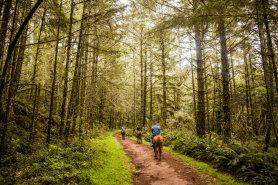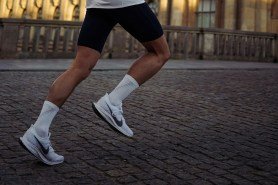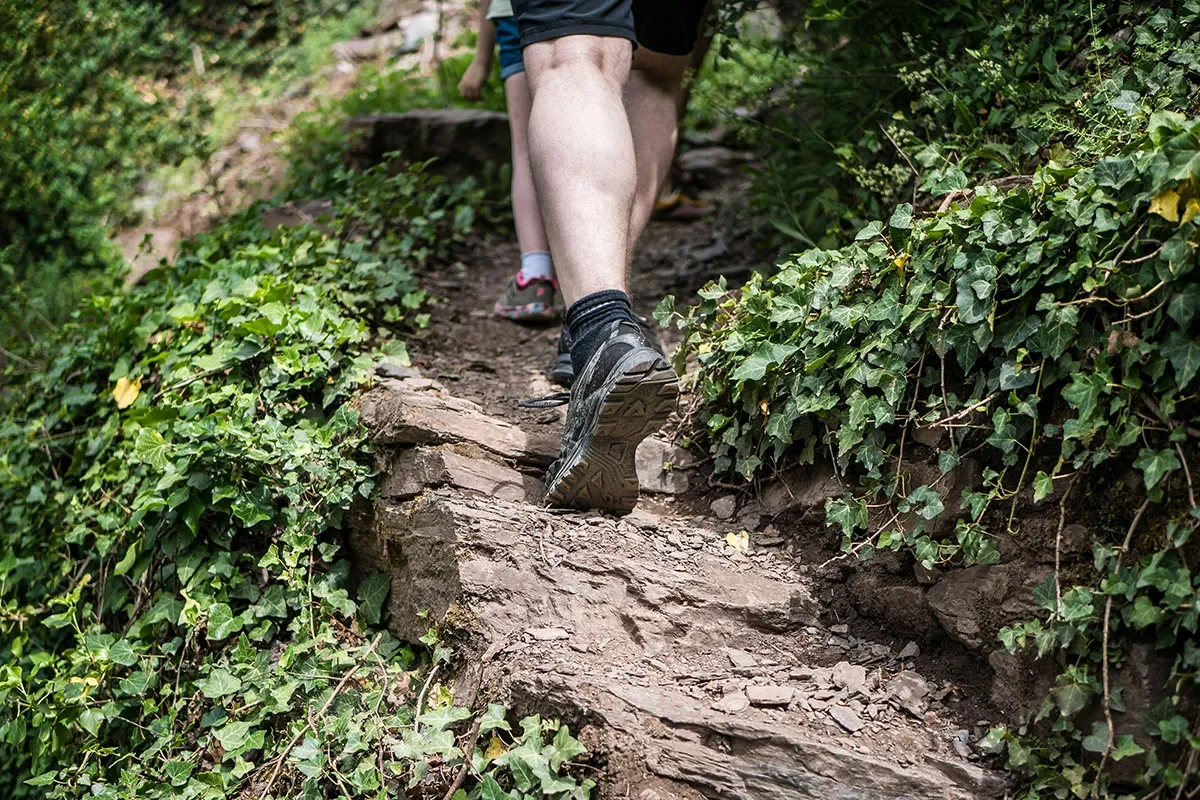

With about 10 percent of the adult population suffering from plantar fasciitis, it’s considered one of the most common causes of heel pain. It feels like stabbing in your plantar fascia, or the thick band of tissue on the bottom of your foot that stretches over your heel bone, each time you step.
Medical experts say plantar fasciitis has a number of causes, including ill-fitting shoes, foot structure, walking surfaces, and too much walking or standing. While we can’t always control where we walk or how much time we spend on our feet, we can buy shoes that fit properly. And when shoes are properly sized and designed to support the structure of our feet, we can go about our business with greater comfort and confidence.
That’s why in this article we’ll list the best hiking shoes for plantar fasciitis. While we’ll share the best hiking shoes overall—we picked the Hoka Anacapa Breeze Low—we’ll also reveal the most supportive hiking shoe for trail running, your budget, and the best hiking boot.
This post contains affiliate links. Outdoors.com may earn a commission when you make a purchase through these links. Thank you for your support.
The Best Hiking Shoes for Plantar Fasciitis
- Best Overall: Hoka Anacapa Breeze Low – Men & Women
- Runner Up: Lowa Renegade GTX – Men & Women
- Best Budget: Columbia Newton Ridge – Men & Women
- Best Trail Runner: Hoka Challenger 7 – Men & Women
- Best Hiking Shoe: Merrell Moab 3 – Men & Women
- Best Hiking Boot: Keen Targhee II Mid Hiking Boots – Men & Women
- Best Sandals: Kuru Tread – Men & Women
Best Overall: Hoka Anacapa Breeze Low – Men & Women
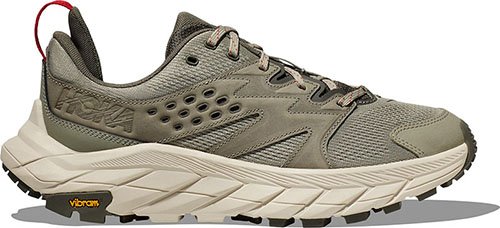
The Hoka Anacapa Aero Low hiking shoes provide special technology, including rocker-style soles, that can help to alleviate the symptoms of plantar fasciitis. We’ve picked this style as our first choice thanks to the shoe’s great design and breathable comfort.
The shoes benefit from highly ventilated knit uppers, a molded EVA foam midsole for responsive cushioning, and special heel technology to keep your foot in place.
These shoes have been approved by the American Podiatric Medical Association (APMA) Seal of Acceptance for promoting good foot health.
Buy Men’s
Buy Women’s
Runner Up: Lowa Renegade GTX – Men & Women
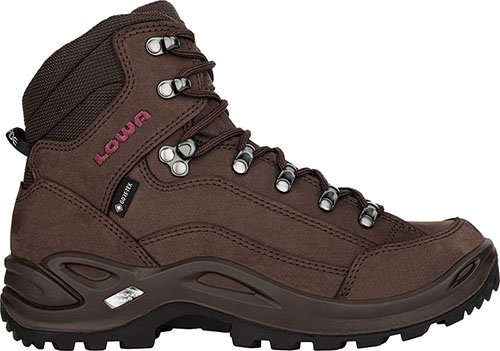
The Lowa Renegade boots are a great waterproof pair of sturdy hiking boots that offer plenty of arch support for long days on the trails. These are widely considered to be one of the best hiking boots for plantar fasciitis right now.
With a nubuck leather upper and a breathable Gore-Tex lining, they are lightweight and durable. Nylon stabilizers offer extra underfoot support and rubber outsoles provide excellent traction on rough terrain. These boots will keep your feet dry all day long.
The boot comes up over the ankle, which is something reviewers loved. Many mentioned walking for hundreds of miles in these reliable boots.
Buy Men’s
Buy Women’s
Best Budget: Columbia Newton Ridge – Men & Women
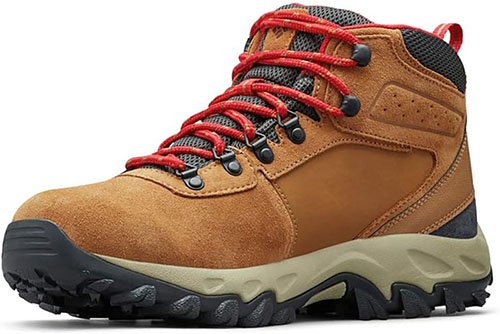
The Newton Ridge range of hiking boots from Columbia offers hikers seamless comfort for all-terrain hikes at good value for money.
The upper is made from a mix of leather, suede, and mesh, which creates a supportive hiking boot and keeps your feet dry and comfortable when the weather is wet. The specially engineered midsole provides cushioning and absorbs impact, allowing you to tackle all kinds of uneven terrain comfortably.
The tread pattern can adapt to a variety of different surfaces, so you can always stay sure-footed. The price, which we’ve seen online for as little as $35, is excellent value considering the technology of the boots. They have plenty of positive reviews with many users complimenting their comfort and durability.
Buy Men’s
Buy Women’s
Best Trail Runner: Hoka Challenger 7 – Men & Women
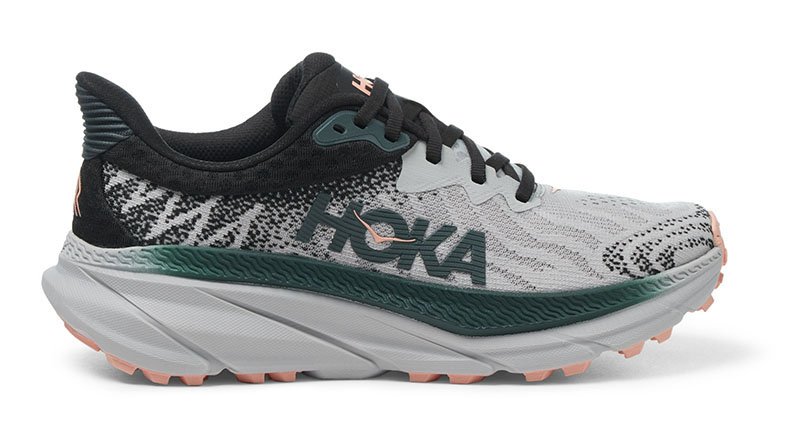
From road-running performance to impressive trail traction, the Hoka Challenger 7 shoes offer outdoors lovers a versatile option for many activities.
The Challenger 7s feature an increased stack heel height, a lightweight and breathable mesh upper, and soft foam midsoles with added cushion. One reviewer mentioned that wearing these shoes feels like “walking on clouds.”
The trail runners come in a variety of eye-catching color combinations. The lugs on the outsole are inspired by gravel tires, making them very reliable on uneven terrain.
Buy Men’s
Buy Women’s
Best Hiking Shoe: Merrell Moab 3 – Men & Women
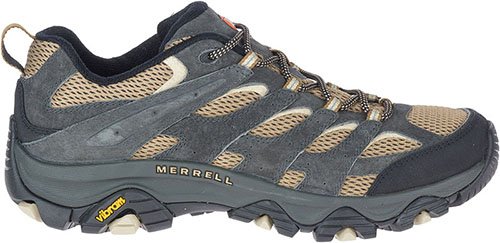
For a hiking shoe that offers extra protection and comfort for sensitive feet, the Merrell Moab 3 is a wonderful choice.
The shoe features molded arch shanks to add stability on harsh and uneven surfaces, and the waterproof exterior protects you from bad weather. They offer a snug fit through the ankle, while rubber toe caps and grippy outsoles work together to keep your feet happy on long adventures.
Made from sustainable materials, you can always count on Merrell to create a good quality and responsibly produced hiking shoe.
Buy Men’s
Buy Women’s
Best Hiking Boot: Keen Targhee II Mid Hiking Boots – Men & Women
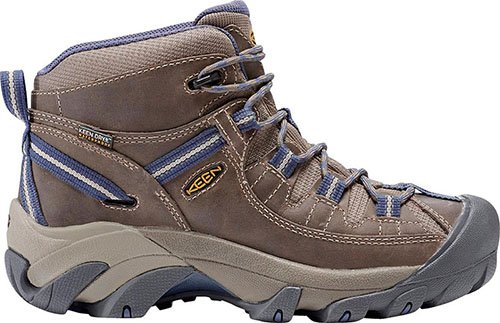
The Keen Targhees are tough boots with a deserved loyal following in the outdoors community. The Targhee II boots provide a supportive design that hikers with symptoms of plantar fasciitis will appreciate.
The upper is made from leather, which adds extra durability. A leather and mesh upper, wide toe box, and a removable insole make the shoes comfortable for long hours of strenuous hiking.
They have KeenDry waterproof membranes to keep feet dry and allow sweat to dissipate quickly. They feature odor-resistant technology and mud shields to help keep you clean and dry on the trails.
Buy Men’s
Buy Women’s
Best Sandals: Kuru Tread – Men & Women
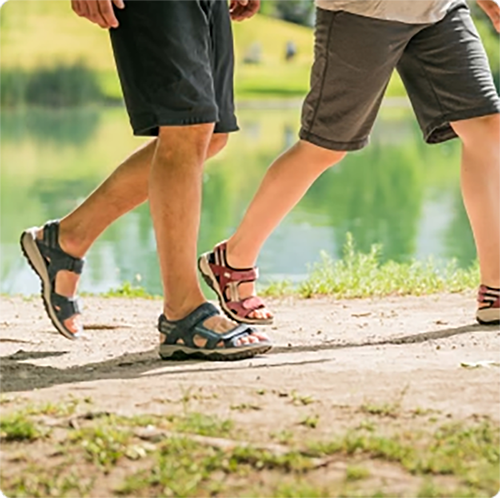
According to the brand Kuru, their footwear is designed to protect the plantar fascia and maximize the body’s natural cushioning.
These sandals feature a custom sole and heel pad cushioning to help minimize foot pain while you are out wandering. For long days in hot weather, a pair of comfortable sandals can be a breathable alternative to wearing sneakers.
With excellent traction, durability, and added heel protection, these sandals might not be the most stylish shoes in the world, but they are certainly a winner when it comes to comfort and wearability.
Buy Men’s
Buy Women’s
Plantar Fasciitis: Causes, Symptoms, and Treatment
There is a long list of things that can cause plantar fasciitis pain. They range from too much walking or running to wearing ill-fitting shoes or no shoes to walking on uneven terrain or standing too long on flat ground.
While people with high arches or who experience sudden weight gain might be more susceptible to plantar fasciitis, the thread that runs through all of the causes is overuse. Experts with the American Podiatric Medical Association say repetitious behavior paired with another variable like improperly fitting shoes or poor foot support can lead to plantar fasciitis pain.
Plantar fasciitis symptoms are often described as a stabbing pain in your mid-heel or heel bone along with stiffness. While it might feel sudden with an awkward step, it most often feels the worst right after you wake up in the morning or after a workout.
While you could self-diagnose plantar fasciitis—you can self-diagnose anything you want—a doctor or podiatrist may consider other variables in addition to foot pain before offering a diagnosis. They will look at the way you walk as well as take an x-ray or ultrasound of your foot to rule out other issues like a stress fracture.
For treatment and to reduce pain, medical experts will advise you to take an over-the-counter medication like ibuprofen; give you a stretching routine; tell you to rest, ice, and wear a night splint or boot; and wear shoes with built-in arch support or orthotic insoles (we’ll get into more of that later).
It’s also not uncommon for doctors to advise that you meet with a physical therapist for physical therapy. In more extreme cases, a doctor may suggest more invasive treatments like steroid injections, shockwave therapy, or even surgery.
How to Find Hiking Shoes for Plantar Fasciitis
When you’re looking for shoes for plantar fasciitis, you’ll want to make sure they’re designed to address the issues that lead to plantar fasciitis pain, such as additional arch support and roomy toe box, but are also designed as functional hiking shoes.
Wear Shoes With Built-in Arch Support
It doesn’t matter if you have high arches or flat feet, experts recommend that you wear shoes that offer stability and support for your arch. You can test this by looking at the rigidity of the shoe.
Experts say a stable and supportive shoe design will bend at the ball of the shoe—not in the middle—and it won’t flop side to side. To say it another way, if the sole of the shoe is too flexible, it won’t adequately support your arch, so you want a durable rubber outsole.
Use Orthotic Insoles
While shoes may be designed to support and stabilize all feet, they will almost always come with generic removable insoles. As many shoe salesmen have explained to me, shoemakers do that to keep the price of the shoe as low as possible.
With that said, those who choose to replace the removable insole often do so with custom orthotics, which are designed to correct foot problems or relieve foot pain.
An orthotic insole will be designed to support a specific foot shape, meaning high arches, flat feet, or something in between. The purpose of it is to help fill out the space between your foot and the inside of the shoe.
Wide Toe Box
Experts say if your shoes are too tight, it can exacerbate plantar fasciitis. To avoid this, you should determine if you have wide or narrow feet and then buy shoes with a roomy toe box. As the name suggests, the toe box is the section of the shoe that protects your toes.
Features of a Hiking Shoe
If your goal is to buy a pair of shoes so you can hike, then you’ll want hiking shoes, hiking boots, or trail running shoes. While they’re all different categories of shoes (see hiking shoes vs. trail runners and hiking boots vs. hiking shoes), they have multiple overlapping qualities.
- Hiking shoes are like heavy-duty walking shoes. They’re constructed with durable materials, lugs on the soles, a rock plate to protect your foot from piercing rocks, and extra cushioning and support.
- Hiking boots have the same qualities as hiking shoes, but they have a higher cuff for greater ankle support. They’re also generally considered to be warmer because there’s more material.
- Trail running shoes are a cross between hiking shoes and running shoes. They are durable and protective like hiking shoes but flexible like running shoes.
FAQs About Shoes for Plantar Fasciitis
Do I need to wear orthotic inserts with shoes for plantar fasciitis?
It depends. Experts say if you have an extreme foot shape like an extremely high arch or extremely flat feet, it could be contributing to your plantar fasciitis. And if that’s the case, you should wear an orthotic insert that supports your foot shape.
Can I wear sandals or flip-flops if I have plantar fasciitis?
Sandals and flip flops often lack qualities like arch support and ample cushioning needed to alleviate the symptoms of plantar fasciitis. However, some brands make supportive or recovery shoes that do provide support.
What shoe features should I avoid if I have plantar fasciitis?
You should avoid wearing shoes with key features like flat soles, minimal arch support, narrow toe boxes, and inadequate cushioning.
How often should I replace my shoes if I have plantar fasciitis?
For hiking shoes, trail running shoes, running shoes, and walking shoes, experts recommend that you replace them every 300 to 500 miles.
Do I need to break in new hiking shoes for plantar fasciitis?
Because hiking boots and shoes are built for protection and durability, they tend to need a break-in period. The length of time varies by brand, but experts say it can take anywhere from one to four weeks. Trail runners, on the other hand, are often good to go out of the box.
Can shoes alone cure plantar fasciitis?
No. A cushioned shoe with more ample arch support is often just part of a comprehensive treatment plan to address plantar fasciitis, which may also include stretching, orthotic inserts, physical therapy, and other treatments.
Should I consult a healthcare professional before buying shoes for plantar fasciitis?
Yes. The guidance provided by a licensed medical professional reviewing your individual case will always trump the general information you find on the internet. A podiatrist will diagnose your condition based on his or her professional expertise while taking into consideration your lifestyle and medical history.
Final Thoughts
It might take a little bit of research to find the perfect hiking shoes for you, but it will be time well spent when you don’t have to worry about foot pain on a long trail.
Comfort is the most important factor to consider with hiking shoes, especially if you struggle with plantar fasciitis.
You can’t go wrong with our top pick, the Hoka Anacapa Breeze Low. These hiking shoes offer an endlessly lightweight, supportive, and easy-to-wear design. For something that offers extra waterproof protection, the Lowa Renegade GTX hiking boots are another excellent choice.


